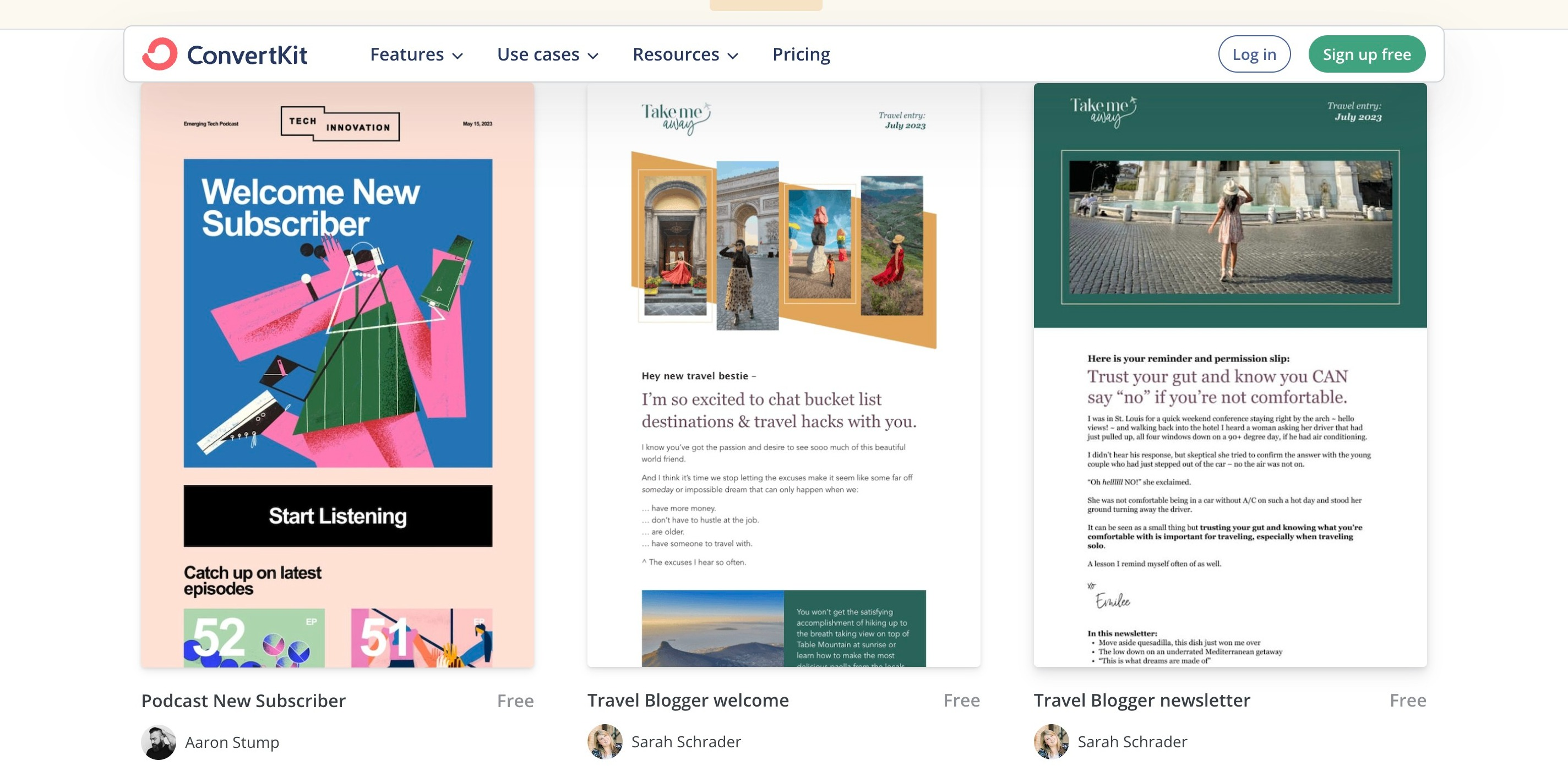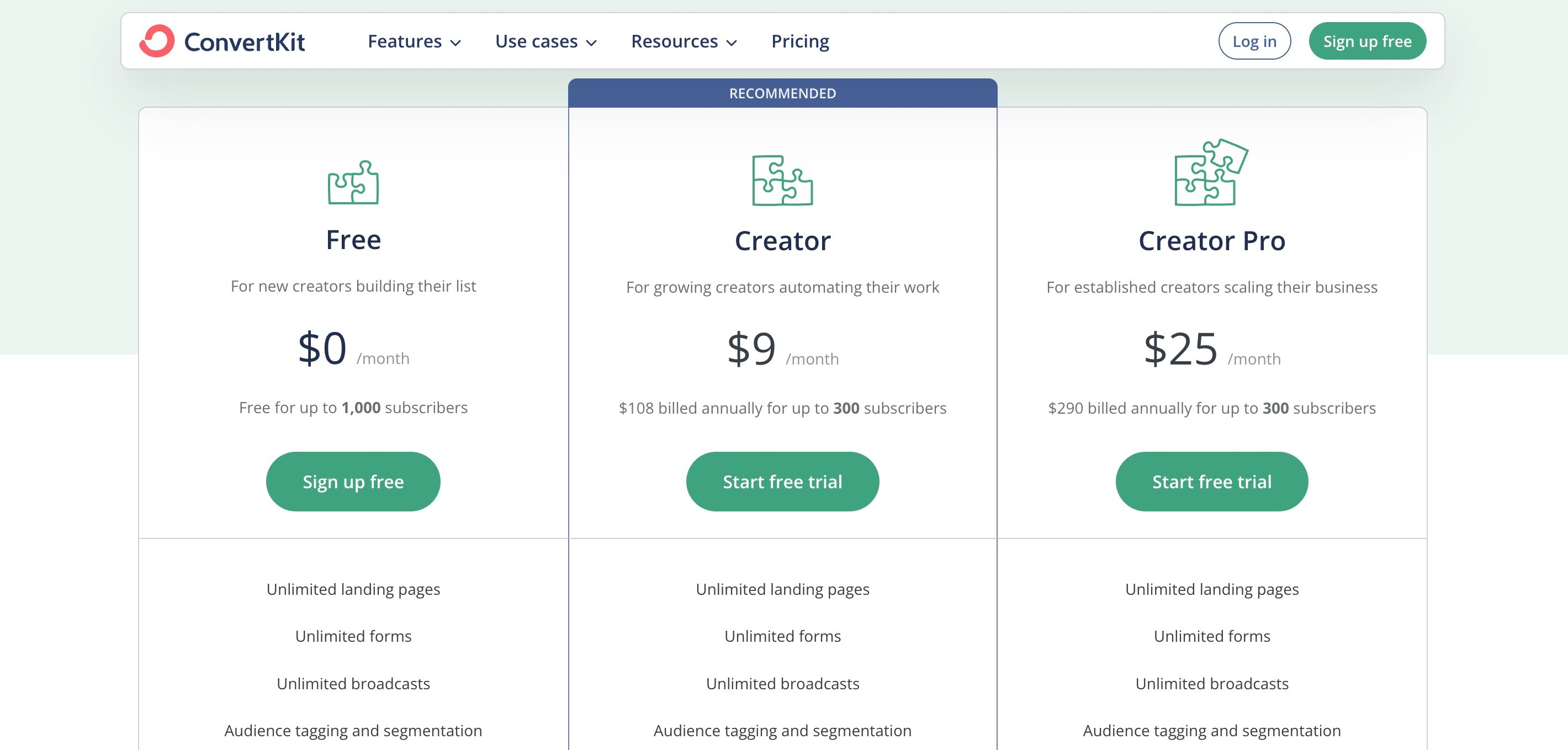ConvertKit vs Mailchimp: Which Email Marketing Tool Is Better Overall?

When you buy something through one of the links on our site, we may earn an affiliate commission.
Having an email list is one of the best things you can do for your business, and choosing the right platform can make all the difference to your experience with email marketing. In this guide, we’re comparing two of the most popular email marketing platforms around, ConvertKit vs Mailchimp, to see which comes out on top in a side-by-side comparison.
In a rush? Don’t worry, here’s what you need to know.
Overall, ConvertKit is the winner for us. Although on the surface, it looks like Mailchimp has more to offer, ConvertKit is actually far more user-friendly, with beautiful templates and thoughtfully designed automation sequences to help maximize your conversions.
Contents
- ConvertKit vs Mailchimp: Three Key Differences You Should Know About
- A Quick Overview of ConvertKit
- A Quick Overview of Mailchimp
- ConvertKit vs Mailchimp: Feature Comparison
- Convertkit vs Mailchimp: Which is Easier to Use?
- Integrations
- ConvertKit vs Mailchimp: The Pros and Cons
- ConvertKit vs Mailchimp: Pricing
- ConvertKit vs Mailchimp: The Verdict
ConvertKit vs Mailchimp: Three Key Differences You Should Know About
- ConvertKit’s free plan allows you to have up to 1,000 subscribers and send unlimited emails at no cost. Mailchimp’s free plan has a sending limit of 1,000 emails per month, which could be very restrictive.
- Although Mailchimp technically has more features, this actually makes it a little more complicated to use. ConvertKit is easier to use than Mailchimp, with streamlined automation sequences that are designed to convert.
- ConvertKit has better eCommerce features, enabling you to sell directly to your audience from the ConvertKit platform.
A Quick Overview of ConvertKit

ConvertKit is a powerful email marketing platform designed specifically for creators such as bloggers, podcasters, and YouTubers. It offers a range of features designed to help users build and manage their email lists, create email marketing campaigns, and automate many aspects of their email marketing strategy.
It’s known for its ease of use and simplicity. This makes it a popular choice for bloggers, creators, and small businesses looking to start or grow their email list.
In terms of email automation, ConvertKit offers more flexibility than Mailchimp. This makes it a great choice for those who want to make email marketing nice and easy. There is a fantastic free version available with an easy-to-use email editor, so if you’re new to email marketing, you can start growing your list without paying a penny.
A Quick Overview of Mailchimp

Mailchimp is currently the most popular email marketing platform on the market. It offers a variety of practical tools to help businesses of all sizes with their online marketing. Initially started as an email marketing service, Mailchimp has since been acquired by Intuit and expanded its offerings to include a wider range of marketing and business tools.
If you’re putting together larger email marketing campaigns or managing streams for more than one business, then Mailchimp is a great choice. The templates it offers and the way this can work with your own business branding are great. This makes it a popular choice amongst experienced email marketers and beginners alike.
Much like ConvertKit, Mailchimp also has a free basic version available to get you started, but with lower usage limits.
ConvertKit vs Mailchimp: Feature Comparison
Now, let’s take a look at some of the features offered by these two email marketing services to see how they measure up side by side.
Email Templates: ConvertKit Wins!

The Convertkit marketplace offers a good selection of premade templates, which are categorized according to type.
Template types on offer include:
- Content Promotion
- Newsletter
- Product Sales Pitch
- Waitlist
These are all currently free of charge, so you can choose one you like and edit it to match your own branding.
Mailchimp offers email templates directly too, in both drag-and-drop formats and AI-enhanced layouts that cover a range of different needs.

Templates are available on all paid plans without restriction. The free plan offers limited use only.
With both ConvertKit and MailChimp, you have the option to create your own custom-coded email templates using HTML.
Marketing Automation: ConvertKit Wins!
Both ConvertKit and Mailchimp offer great marketing automation features, which is a great way to help ensure the success of any email marketing campaign.
ConvertKit has a range of options for creating automated emails, including a new visual automation feature.

When you want to create an automation workflow, you simply click into their sequence feature, which, as the name suggests, allows you to build a sequence of emails. You can create and edit emails within this process too.
MailChimp has recently updated its automation options, too, with a choice of simple workflows that you can choose from.
Neither ConvertKit nor Mailchimp offer automations on the free plan, so you will need to be on a paid plan to take advantage of these features.
Mailchimp allows up to four ‘journey points’ in an automation sequence on the Essentials plan. If you need more than this, you will have to choose one of the higher paid plans, which allow up to 200 journey points.
ConvertKit doesn’t put a cap on the steps in an automation sequence. This means you can simply choose the automation that’s best for your campaign, even on the lowest paid plan.

That said, email automation is something ConvertKit is passionate about, so if you’re looking to pick one that is the best, it probably takes the title.
Landing Pages: It’s a Tie!
Getting people to subscribe to your mailing list can sometimes feel like a battle, so knowing that your email marketing software can help with this is great news. Landing pages need to be effective in creating conversions from website hits, so when it comes to creating pages, it’s important to get it right.

ConvertKit's email editor includes 50 templates that allow you to get started with putting together and designing slick landing pages. You can choose from over 100,000 images and add them to your page in one click, thanks to the Unsplash integration.

They also have a simple editor that allows you to make basic changes to the templates, but it is worth noting that the changes you can make are limited.
MailChimp has just 10 templates to start with, but they also have some blank layouts if you want to design your own. They make it really easy to make any changes you’d like to the design with a landing page editor and a drag-and-drop facility for adding blocks of content.

Both of these email marketing tools will allow you to create beautiful landing pages in minutes, so in this round, it’s a tie.
Opt-in Forms: It’s a Tie!
Both ConvertKit and Mailchimp have a built-in form builder that allows you to create forms that fit in with the rest of your website. You can use the form you have created to capture email addresses on any page on your website or via a landing page.
ConvertKit allows you to set up sticky bars, inline forms, and/or slide-in options, which means that you can ensure that whatever form you set up works for you and your needs.
MailChimp has a similar form builder with three main tabs - build it, design it, and translate it so you can look at how to create effective sign-up forms.
Both offer great options for creating forms, with ConvertKit often receiving great reviews for its ease when it comes to creating sign-up forms and collecting data.
List Management: Mailchimp Wins
Being able to keep track of your subscribers, understand where they came from, and what sort of emails they’d like to receive is a great way to ensure that you get the most out of your email marketing software.
It is worth considering that ConvertKit doesn’t do list management in the same way as Mailchimp. Instead, when you upload contacts to ConvertKit, you’re able to assign them to a form or add a tag to them. This allows you to see whether people belong to the same tag and is a way of keeping your contacts as organized as possible.
Mailchimp works differently with list management and allows you to add contacts to separate lists. This is a great option for those who are managing email marketing for more than one client. You can also separate people with different tags and groups, meaning that you get to organize lists within lists.
Overall, Mailchimp comes out on top for those who have extensive campaigns or multiple email marketing streams to take care of. However, ConvertKit definitely does the job for those who have a simpler list of requirements.
Reporting and Analytics: MailChimp Wins
ConverKit’s analytics area enables you to see basic performance reports such as delivery rates, open rates, and click-throughs, but anything above this is limited.
This does make reporting easy to use on Convertkit, but if you want analytics on things like automation and campaign comparison, you’ll need to use Mailchimp.
For ease of use, ConvertKit comes out on top, but simply because its basic options mean it’s easy to find the information you want.
Deliverability: It’s a Tie!
Deliverability within the two email software choices is a pretty even race. Both will tell you that they have great Deliverability rates - and to be fair to them, they’re not wrong.
However, when you look into the testing of both, they’re pretty much on an even footing when it comes to actual, tested performance.
Convertkit vs Mailchimp: Which is Easier to Use?
Overall, it has to be said that ConvertKit is easier to use. The sleek templates and effective automation sequences make it easy for anyone—even complete beginners—to create powerful email marketing campaigns for their business.
Mailchimp's interface is a little harder to get to grips with, and although it offers a few more features than ConvertKit, it’s not quite as intuitive to use.
Integrations

Both Mailchimp and ConvertKit integrate with most major platforms, such as Facebook and Shopify. ConvertKit currently offers over 120+ integrations with the platform. This includes Zapier, so if there is an integration you need that’s not listed, you can connect using Zapier.
However, with over 250+ native integrations on offer, MailChimp comes out on top in this area.

ConvertKit vs Mailchimp: The Pros and Cons
As you might imagine, with software that offers such comprehensive features, there are different pros and cons to each one. It’s important to look at each of these to see if there’s anything that would be a dealbreaker for you.
Convertkit Pros and Cons
Pros:
- User friendly interface
- Completely free plan available
- Visual automations
- Reliable
- A/B test subject lines for broadcast emails
- Good deliverability
- Easy tagging and segmentation features
Cons:
- Basic reporting features
- No A/B testing for subject lines in automation sequences
Mailchimp Pros and Cons
Pros:
- Great value paid plans
- Excellent list management features
- Easy to use
- A/B testing facilities
- Marketing automation
- Detailed reporting and analytics
- Over 220+ native integrations
Cons:
- The free plan is very limited
- It counts unsubscribed or inactive contacts as part of your plan until you delete them completely
- Quite expensive
ConvertKit vs Mailchimp: Pricing
Let's see how much each of these email marketing tools will set you back.
ConvertKit Pricing

- Free. Allows you to send emails to up to 1,000 subscribers. Unlimited landing pages and forms are included. Community support is included (live chat and email support not included)
- Creator. Starts at $9 per month. Allows you to send emails to up to 300 subscribers. Live chat and email support are included. Features such as automated email sequences, visual automation builders, and third-party integrations are included.
- Creator Pro. Starts at $25 per month. Allows you to send emails to up to 300 subscribers. As above (with priority customer support), but with additional newsletter features and advanced reporting.
For 5000 contacts, ConvertKit will cost $66 per month on the Creator plan or $93 on Creator Pro.
Mailchimp Pricing

- Free. A free option with basic capabilities and email support for your first month. Allows you to send 1,000 emails to one audience.
- Essentials. $13/month for 500 contacts. Allows you to send 5,000 emails to three audiences per month. You can access email and live chat support, with pre-built email templates but limited reporting.
- Standard. $20/month for 500 contacts. Allows you to send 6,000 emails to five audiences per month. You get access to the same email templates and chat support but with more comprehensive reporting.
- Premium. $350/month. Allows you to send 150,000 emails to as many audiences as you like per month. You also get access to priority support, including phone support. You can also automate customer emails at up to 200 journey points.
For 5000 contacts, Mailchimp will set you back $75 for the Essentials plan, $100 on the Standard plan, or $350 for the Premium plan.
ConvertKit vs Mailchimp: The Verdict
So, who wins in the battle between ConvertKit vs MailChimp?
If you’re a blogger or creator looking to automate your marketing, ConvertKit is undoubtedly the tool for you. This email marketing tool offers amazing value for money and best of all, it’s super intuitive and easy to use. The choice of templates and automation sequence takes all of the stress and guesswork out of your email marketing.
Check out our full ConvertKit review for more info.
That being said, if you are a larger business running multiple campaigns for different contact lists, Mailchimp is definitely worth considering. It has fantastic analytics features, allowing you to dive deep into the numbers. Like ConvertKit, Mailchimp has a free plan, so you can test the waters and see if you get on with it before committing to a paid plan.
Still undecided? Check out our list of the best email marketing software to see who made the top of the list!
Want to learn step-by-step how I built my Niche Site Empire up to a full-time income?
Yes! I Love to Learn
Learn How I Built My Niche Site Empire to a Full-time Income
- How to Pick the Right Keywords at the START, and avoid the losers
- How to Scale and Outsource 90% of the Work, Allowing Your Empire to GROW Without You
- How to Build a Site That Gets REAL TRAFFIC FROM GOOGLE (every. single. day.)
- Subscribe to the Niche Pursuits Newsletter delivered with value 3X per week
My top recommendations
















